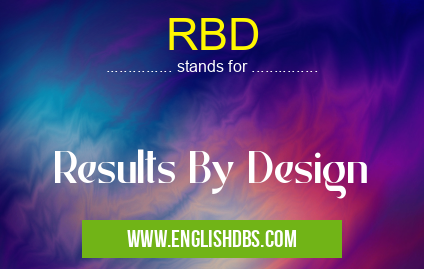What does RBD mean in UNCLASSIFIED
RBD is an acronym that stands for Results By Design. It is a methodology that focuses on achieving specific, measurable, and achievable results. It is based on the idea that by understanding the results you want to achieve, you can design a plan to achieve them.

RBD meaning in Unclassified in Miscellaneous
RBD mostly used in an acronym Unclassified in Category Miscellaneous that means Results By Design
Shorthand: RBD,
Full Form: Results By Design
For more information of "Results By Design", see the section below.
Key Principles of RBD
- Start with the end in mind: Clearly define the results you want to achieve before you start planning.
- Break down goals into smaller steps: Make your goals more manageable by breaking them down into smaller, achievable steps.
- Measure progress regularly: Track your progress towards your goals to ensure you are on track.
- Adjust your plan as needed: Be willing to make changes to your plan if you are not getting the results you want.
Benefits of using RBD
- Clarity: RBD helps you to clarify your goals and objectives.
- Focus: It helps you to stay focused on the most important tasks.
- Accountability: It holds you accountable for your results.
- Empowerment: It empowers you to take control of your results.
How to Implement RBD
- Define your goals: What do you want to achieve?
- Break down your goals: How can you break down your goals into smaller, more achievable steps?
- Develop a plan: What steps will you take to achieve your goals?
- Measure your progress: How will you track your progress towards your goals?
- Adjust your plan: Make changes to your plan as needed to ensure you are on track.
Essential Questions and Answers on Results By Design in "MISCELLANEOUS»UNFILED"
What is Results By Design (RBD)?
Results By Design (RBD) is a methodology that focuses on achieving specific, measurable, achievable, relevant, and time-bound (SMART) goals. It provides a structured approach to planning, implementing, and evaluating interventions to maximize effectiveness.
How does RBD differ from traditional approaches to goal setting?
Traditional approaches often lack a systematic and rigorous framework for setting and achieving goals. RBD, on the other hand, emphasizes the involvement of stakeholders, evidence-based practices, and ongoing monitoring and evaluation to ensure that goals are met effectively and efficiently.
What are the key components of RBD?
The key components of RBD include:
- Goal setting: Identifying and articulating SMART goals that are aligned with organizational objectives.
- Planning: Developing a detailed plan outlining the steps, resources, and timelines required to achieve the goals.
- Implementation: Executing the plan and making any necessary adjustments along the way.
- Monitoring and evaluation: Regularly tracking progress, identifying challenges, and making data-driven decisions to improve outcomes.
What are the benefits of using RBD?
RBD offers numerous benefits, including:
- Increased focus and clarity: SMART goals provide a clear roadmap for action, ensuring that efforts are aligned and focused on achieving the desired outcomes.
- Enhanced accountability: The structured framework of RBD promotes accountability and responsibility, as stakeholders are actively involved in the goal-setting and implementation process.
- Improved decision-making: Data-driven monitoring and evaluation allow for informed decision-making, enabling organizations to adjust their strategies based on evidence.
- Greater success rates: The systematic and rigorous approach of RBD increases the likelihood of achieving goals and realizing desired outcomes.
Final Words: RBD is a powerful methodology that can help you achieve your goals. By following the principles of RBD, you can develop a plan that is designed to help you succeed.
RBD also stands for: |
|
| All stands for RBD |
